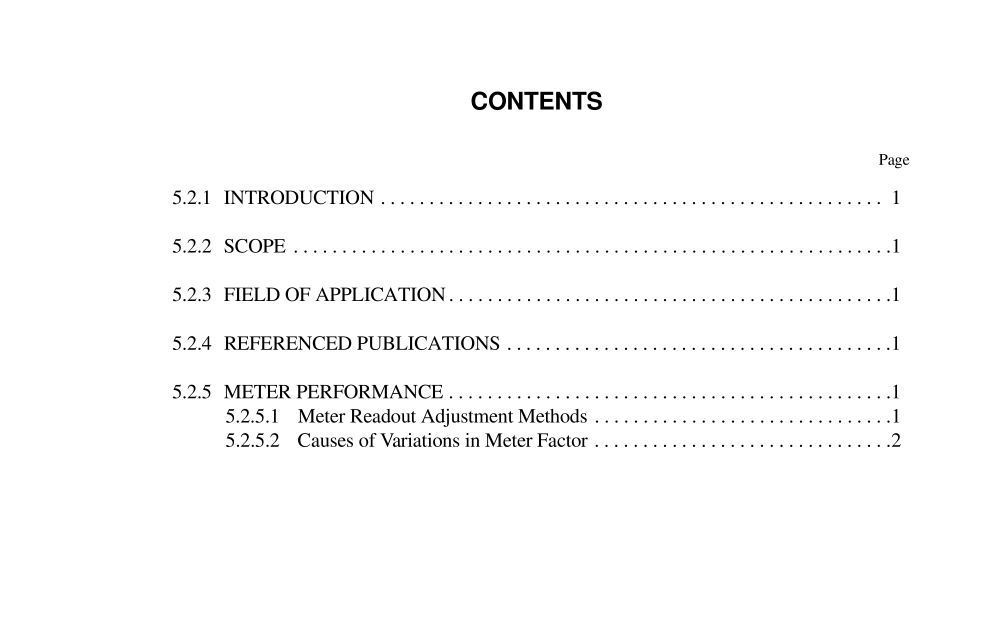API MPMS 5.2 pdf download

API MPMS 5.2 pdf download.Manual of Petroleum Measurement Standards
5.2.1 Introduction
API MPMS Chapter 5.2, together with the general consid- erations for measurement by meters found in API MPMS Chapter 5.1, describes methods for obtaining accurate quan- tity measurement with displacement meters in liquid hydro- carbon service. A displacement meter is a volume measuring device which separates a flowing liquid stream into discrete volumes and counts the separated volumes. The meter carries through its measuring element a theoretical swept volume of liquid, plus the slippage for each stroke, revolution, or cycle of the mov- ing parts. The indicated volume of the displacement meter must be compared with a known volume that has been deter- mined by proving, as discussed in MPMS Chapter 4. It is recognized that meters other than the types described in this chapter are used to meter liquid hydrocarbons. This publication does not endorse or advocate the preferential use of displacement meters, nor does it intend to restrict the development of other types of meters.
5.2.5.1 METER READOUT ADJUSTMENT METHODS
Either of two methods of meter readout adjustment may be used, depending on the meter’s intended application and anticipated operating conditions. 5.2.5.1.1 Direct Volume Readout Method With the first method the readout is adjusted until the change in meter reading during a proving equals or nearly equals the volume measured in the prover. It is then sealed to provide security against unauthorized adjustment. Adjusted meters are most frequently used on retail delivery trucks and on truck and rail-car loading racks, where it is desirable to have a direct quantity readout without having to apply mathematical corrections. An adjusted or direct-reading meter is correct only for the liquid and flow conditions at which it was proved. 5.2.5.1.2 Meter Factor Method With the second method of meter readout adjustment, the meter readout is not adjusted, and a meter factor is calculated. The meter factor is a number obtained by dividing the actual volume of liquid passed through the meter during proving by the volume indicated by the meter. For subsequent metering operations, the actual throughput or measured volume is determined by multiplying the volume indicated by the meter by the meter factor (see Chapter 4 and Chapter 12.2).When direct quantity readout is not required, the use of a meter factor is preferred for several reasons: a. It is difficult or impossible to adjust a meter calibrator mechanism to register with the same resolution that is achieved when a meter factor is determined. b. Adjustment generally requires one or more reprovings to confirm the accuracy of the adjustment. c. In applications where the meter is to be used with several different liquids or under several different sets of operating conditions, a different meter factor can be determined for each liquid and for each set of operating conditions. For most pipelines, terminals, and marine loading and unloading facilities, meters are initially adjusted to be correct at average conditions, and the mechanisms are sealed at that setting. Meter factors are then determined for each petroleum liquid and for each set of operating conditions at which the meters are used. This method provides flexibility and main- tains maximum accuracy. 5.2.5.2 CAUSES OF VARIATIONS IN METER FACTOR There are many factors which can change the performance of a displacement meter. Some factors, such as the entrance of foreign matter into the meter, can be remedied only by eliminating the cause of the problem. Other factors depend on the properties of the liquid being measured; these must be overcome by properly designing and operating the metering system. The variables which have the greatest effect on the meter factor are flow rate, viscosity, temperature, and foreign matter (for example, paraffin in the liquid). If a meter is proved and operated on liquids with inherently identical properties, under the same conditions as in service, the highest level of accu- racy may be expected. If there are changes in one or more of the liquid properties or in the operating conditions between the proving and the operating cycles, then a change in meter factor may result, and a new meter factor must be determined.









